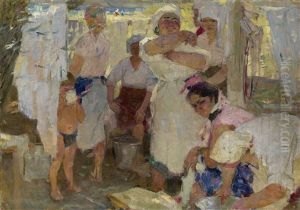Petr Ivanovich Kotov Paintings
Petr Ivanovich Kotov was a Russian artist known for his work in painting, particularly during the Soviet era. Born on September 16, 1889, in the village of Khoten, which is now in the Donetsk region of Ukraine, Kotov grew up in the Russian Empire. He became active in the arts during a period of significant political and social change, which would eventually culminate in the Russian Revolution of 1917.
Kotov was educated at the Moscow School of Painting, Sculpture and Architecture, which was one of the most prestigious art schools in Russia at the time. His education provided him with a solid foundation in the academic art traditions of the 19th century, but he would eventually become influenced by the avant-garde movements that were emerging in the early 20th century.
After the October Revolution, Kotov aligned with the Bolsheviks' cause and became an active participant in the cultural initiatives of the new Soviet state. His work reflected the ideological shift towards Socialist Realism, which became the official art form of the Soviet Union. Socialist Realism was characterized by the glorified depiction of communist values, such as the dignity of labor, the heroism of the Soviet people, and the revolutionary spirit.
Throughout the 1920s and 1930s, Kotov produced a significant body of work that included portraits, landscapes, and large-scale works depicting scenes of industrial development and collective farming—subjects that were in line with the state’s objectives. He was also known for his participation in decorating public buildings and contributing to propaganda materials, which were crucial to the state's efforts to disseminate its ideology.
During World War II, Kotov, like many Soviet artists, created works that supported the war effort, focusing on themes of patriotism and the resilience of the Soviet people. His later works continued to reflect the themes promoted by the state, and he remained a respected artist within the Soviet Union until his death.
Petr Ivanovich Kotov passed away on December 2, 1953. While his work is less known internationally, in Russia and the former Soviet states, he is remembered as a representative artist of his time, whose art was closely intertwined with the political and social environment of the Soviet Union. His legacy provides insight into the complex relationship between art and ideology during one of the most turbulent periods in Russian history.







